Entries in wind turbine shadow flicker (28)
2/27/11 WINDKILL: How "Green" is a bird and bat killing machne? AND No matter what language you say it in, wind turbine shadow flicker is intolerable
[Note: Illustrations and photos on this post added by the BPWI Research Nerd]
WIND FARMS AND DEADLY SKIES: TURBINES ON TEXAS COAST KILLING THOUSANDS OF BIRDS AND BATS EACH YEAR
 SOURCE: San Antonio Express-News, www.mysanantonio.com
SOURCE: San Antonio Express-News, www.mysanantonio.com
February 27, 2011
By Colin McDonald,
SARITA — The 260-foot-tall wind turbines of the Kenedy Ranch stand like a steel forest along the edge of the Laguna Madre and pump out hundreds of megawatts of emission-free electricity.
The spinning blades, alongside some of the most important habitat in Texas and one of North America’s largest migratory flyways, are killing thousands of birds and bats each year.
How many isn’t publicly known because, unlike California counties, Texas and the federal government don’t require turbine operators to make public reports, according to state and federal officials.
Aside from the quantity of bird and bat deaths, a more complicated question remains unanswered as more wind turbines are put up along the Texas Coast: Have the turbines changed the ecosystem and displaced wildlife?
For the first time, Pattern Energy, which owns 118 turbines on the ranch, and Iberdrola Renewables, which owns 168, voluntarily released results of their first yearlong studies.
Pattern estimates up to 921 birds and 2,309 bats were killed between Aug. 24, 2009, and July 31; Iberdrola’s estimates: 1,812 birds and 3,087 bats for the same period.
While the bird killings match the national average, one researcher found the bat killings much higher than expected.
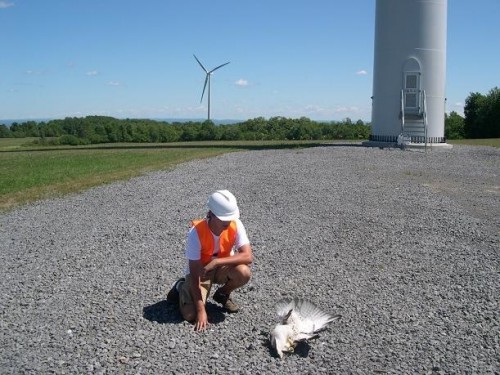 Those who opposed the wind farms are not convinced the studies are credible or conclusive.
Those who opposed the wind farms are not convinced the studies are credible or conclusive.
The work was paid for by the companies and not peer-reviewed. In their reports, biologists wrote about the challenges of collecting good data with rattlesnakes biting their search dogs and cows that would not leave. The researchers estimate scavengers removed half of the bird and bat carcasses before they could be found.
They also could not get federal permits to collect the species they did find, so many had to be marked as unknown.
After more than a year of submitting forms, the companies received a collection permit last month, said Rick Greiner of Pattern Energy.
But of the species identified, none were endangered.
“We think there is a low impact to T and E (threatened and endangered species) because we have not found any,” he said.
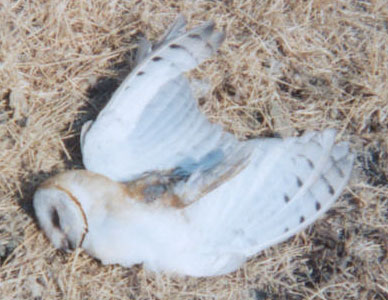
The reports state the wind farms had a bird mortality rate of three birds per megawatt, which is in the middle for the national average of one to six birds, according to the American Wind Energy Association, a trade group. A national average for bats killed per megawatt is not well-established.
In addition to average bird mortality, the companies point to the high-tech radar systems they voluntarily installed that will trigger a shutdown of the spinning turbines during fog or low visibility when a mass of birds or bats is approaching.
As of the end of 2010, a shutdown had not occurred.
“At every stage of the project’s life, Iberdrola Renewables has gone above and beyond what has been required by the state of Texas and federal government to conduct extensive studies and monitor the outcomes of our wildlife protection measures,” said Jan Johnson, a spokeswoman for Iberdrola.
More than numbers
One who disagrees the studies have been extensive is David Newstead, an environmental scientist for the Coastal Bend Bays & Estuaries Program in Corpus Christi and president of the Coastal Bend Audubon Society.
He believes mortality rates are an incomplete measurement of the effect of wind farms. The numbers do not reflect how turbines could be changing behavior of birds and bats by forcing them out of their habitat and putting them under greater stress.
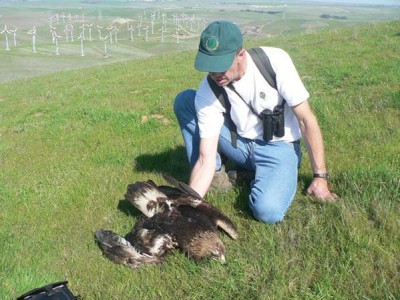 “Cumulative effects are practically never discussed by wind developers,” Newstead said. “At the end of the day, the most important numbers, for the sake of the wildlife, is how many of what species of birds and bats are being not only killed, but displaced.”
“Cumulative effects are practically never discussed by wind developers,” Newstead said. “At the end of the day, the most important numbers, for the sake of the wildlife, is how many of what species of birds and bats are being not only killed, but displaced.”
Newstead is one of most vocal challengers to the construction of wind farms along the Texas Coast and was part of an unsuccessful lawsuit to stop them, funded in large part by the King Ranch, which borders the Kenedy Ranch.
“There is no other place in North America that plays such an important role for so many species during some part of their lives,” Newstead said about the Laguna Madre and surrounding grasslands. “Collision mortality can thus affect any of more than 400 regularly occurring species.”
Newstead’s concerns for the coast only grow as more turbines are built, following the lead of the Kenedy Ranch.
Since the Kenedy turbines came online in 2009, Iberdrola has added more, and the Papalote Creek Wind Farm with 196 units was built outside Corpus Christi, according to AWEA.
When operating at capacity, the Kenedy Ranch turbines in total can generate close to 680 megawatts, or enough electricity to meet the needs of 135,000 to 170,000 homes, according to CPS Energy, which buys power from Iberdrola.
That power is produced during the day when consumer demand is the highest, and it can be delivered via uncongested transmissions lines, said CPS Energy spokeswoman Lisa Lewis, adding that effect on wildlife was not considered when it signed the contract.
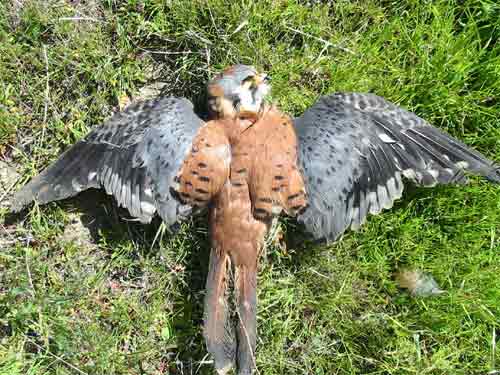
Working with wind
For now, wind companies face few consequences for killing wildlife, explained Paul Schmidt, assistant director at the Migratory Bird Program for the U.S. Fish and Wildlife Service.
While it’s against federal law to kill or harm any endangered, threatened or migratory bird species, the agency has not prosecuted any wind farm owner.
Instead, the service is working with the wind industry, scientists and conservationists to establish guidelines for how wind companies should place and operate a wind farm, Schmidt said.
A draft of those guidelines was released for comment this month.
Once the guidelines are adopted, the Fish and Wildlife Service will have a basis to decide which companies to investigate, Schmidt said.
“It’s just like you’re driving down the highway and the speed limit is 55,” he said. “You can go 60, probably 62, but at some point you are going to get caught.”
Schmidt said companies that volunteer information will avoid the scrutiny given those that do not.
Pattern and Iberdrola have regular communication with the service. But the reports they send are marked “privileged and confidential,” so they can’t be shared.
When Pattern gave its reports to the San Antonio Express-News, it called them public but then requested it preapprove anyone who saw them and that they not be posted online.
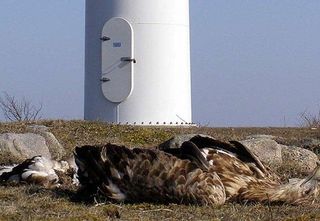 “Clearly we have a problem with transparency with the wind and wildlife issues, and I think we have a ways to go,” said Edward Arnett, director of programs at Bat Conservation International, whom Pattern approved to review its studies.
“Clearly we have a problem with transparency with the wind and wildlife issues, and I think we have a ways to go,” said Edward Arnett, director of programs at Bat Conservation International, whom Pattern approved to review its studies.
With wind farms across the country reluctant to share data openly, the understanding of the cumulative effect on wildlife and the best way to minimize it are stunted, Arnett said. This is especially true of bats.
At 150 feet long, the wind turbine blades move between 100 and 180 mph at their tip. The pressure change on the trailing edge is enough to cause internal hemorrhaging in bats, according to Bat Conservation International.
Before the Kenedy wind turbines went in, Arnett had expected low bat mortality, as there were no known concentrations of bats in the area. Since so little is known about bat movements, he is not surprised the numbers turned out to be higher.
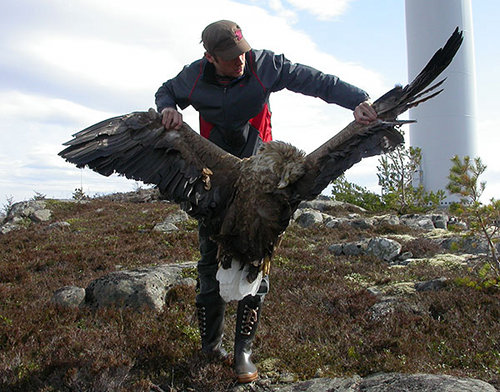 Before wind turbines were built, little was known about bat movements.
Before wind turbines were built, little was known about bat movements.
It isn’t possible to know what is and isn’t working, he said.
“Until we have the information published in a credible fashion that is publicly shared and published in journals, it is going to be unknown,” he said.
SECOND FEATURE:WIND TURBINE SHADOW FLICKER MAKES DANES MISERABLE
THIRD FEATURE
WIND TURBINE SHADOW FLICKER MAKES BADGERS MISERABLE
2/14/11 Be a Sweetheart and contact these legislators AND Our Video of the Day AND Residents say Tell it to the Judge: Lawsuit filed against Town of Forest, alleging under-the-radar granting of turbine permits AND Who are the losers in the Big Wind game?

A VALENTINES DAY MESSAGE FROM THE BPWI RESERCH NERD:
IF YOU + RURAL WISCONSIN = TRUE LOVE, WHY NOT BE A SWEETHEART AND GIVE THESE LEGISLATORS A CALL?
Call the numbers or click on the links below to contact members of the joint committee to thank them for holding last weeks hearing on the PSC's wind siting rules and to ask that the rules be suspended. (Read more ...)
Senator Leah Vukmir (Chair) (R- Wauwatosa) 266-2512, Sen.Vukmir@legis.wisconsin.gov
Representative Jim Ott (Chair) (R- Mequon) 266-0486, Rep.OttJ@legis.wisconsin.gov
Senator Joseph Leibham (R- Sheboygan) 266-2056, Sen.Leibham@legis.wisconsin.gov
Senator Glenn Grothman (R-West Bend) 266-7513, Sen.Grothman@legis.wisconsin.gov
Senator Lena Tayor (D-Milwaukee) 266-5810, Sen.Taylor@legis.wisconsin.gov
Senator Fred Risser (D-Madison) 266-1627, Sen.Risser@legis.wisconsin.gov
Representative Dan LeMahieu (R-Cascade) 266-9175, Rep.lemahieu@legis.wisconsin.gov
Representative Gary Hebl (D-Sun Prairie) 266-7678, Rep.hebl@legis.wisconsin.gov
Representative Fred Kessler (D-Milwaukee) 266-5813, Rep.kessler@legis.wisconsin.gov
Don't forget to include your name and address.
Click on the image above to hear wind turbine noise that includes a whistle. To see a picture of the family living beside these turbines, scroll down. [SOURCE]

CITIZEN GROUP FILES LAWSUIT OVER WIND TURBINE PROJECT
SOURCE: WQOW TV: Eau Claire
Town of Forest (WQOW) - A dispute over wind turbines has now turned into a lawsuit.
This week, a citizen group filed a lawsuit against the Town of Forest. That's north of Glenwood City. An energy company is looking to build more than three dozen wind turbines on various properties in the area. The board approved the measure last year, but residents say they were kept in the dark about the plans.
The group is concerned about diminished land values and noise pollution from the turbines, which could be up to 500 feet tall. The group is asking for a permanent injunction to stop the building of the turbines.
NOTE FROM THE BPWI RESEARCH NERD: Emerging Energies is said to be the wind developer in this project. One of the founders of Emerging Energies is Bill Rakocy, pictured here. Rakocy is on the PSC's wind siting council.
SECOND FEATURE:
Bill Rakocy's company, Emerging Energies, recently put up 500 foot tall turbines in the Town of Glenmore in Brown County. The Shirley Wind project hosts the tallest wind turbines in the state.
Better Plan recently received this email from Steve Deslauriers, a Brown County resident who recently visited a home in this wind project.
"I was graciously invited to go to a neighbor's home that is within approximately 3400 feet of 3 of the 500 foot tall Shirley Wind turbines (the closest being approximately 2700 feet from their home).
They can see 6 of the turbines from their home - the farthest being miles away.
The couple built this home and has lived there for 30 plus years and is now in their mid/upper 60's. They wanted me to experience the effect the turbines are having on them.
I drove up their driveway and got out of my car. I looked around and the presence of the 3 closest turbines are very imposing. I listened and could hear the thrumming of the blades and the whir of the gearboxes, but the noise I could hear has was not particularly loud - the wind speed this morning was 10mph so a pretty calm day.
I walked up to the door and was invited in the house to see the wife wearing industrial earmuffs in her kitchen which she removed right away when I walked in. She went to the doctor this week due to ear pain (a new condition) and the earmuffs help - Doctor found nothing physically wrong.
The husband asked me to sit in his rocker and just left me alone for a while. I heard the whir and whoosh, but it was pretty muffled.
But here is what is scary to me - as I sat there over the course of 10 minutes or so, I could start feeling pressure in my right ear (facing the window that faced the turbines). This was not expected. At first, it was just "weird", but the longer I stayed, the more unsettling it was.
After a while the husband and I walked outside around their home. As we walked on the side of the home, he stopped and I immediately said to him "I know why you stopped here!".
It was a strange phenomenon - that place at that moment, I felt the same 'pressure' he did - must be from how the house is situated, wind direction, etc.
I thought this was very weird so I walked back to the front of the house and came back to that spot a number of times and the same sensation was present each time. It is hard to describe but there is a difference in pressure that you feel in your head. The pressure feeling was present in most places, but particularly bad in some.
The longer I stayed at their home the more unsettled I became. I honestly don't know how else to describe it. Unsettled is the best way - the physical feeling of pressure in my ears did not go away, and the longer we visited, it felt like pressure was being felt in my temples.
This is a feeling that my body was telling me was not good, and quite frankly, I did NOT want to stay. Not because of any lack of hospitality, but the feeling that was in my head was not pleasant at all. It triggered a flight response in me - I wanted to leave. This on a day of 10mph winds....
This couple has offered to invite anyone to their house to experience this first hand. Plan to spending some time there - my body's reaction worsened over time (that is this couples experience as well when they return after being gone a while).
Bring a magazine or newspaper and sit in the husband's chair. While I can't say your reaction will be the same, it is worth your time. Even this couple's reaction to the sound/pressure is different, so sure it will affect each of you in different ways.
This is my first visit of any length inside an affected home and it was eye opening. The setback and wind speeds were certainly not even close to the worst it could be, and despite that, I wanted OUT! ... I could not live there.
THIRD FEATURE:
-Wind developer Gary Haltaufderheide speaking to residents in Rock County, Wisconsin regarding concerns about impacts to non-participating landowners:
In any wind project, "There are always going to to be winners and losers"
BETTER PLAN LOOKS AT SOME OF THE LOSERS:

These are the losers. This family, these children-- now living with noise and shadow flicker from poorly sited turbines. Read about what has happened to their lives since the turbines went on line by CLICKING HERE to visit their website
MORE LOSERS:
"The retired 61-year-old furniture maker said the turbines give him nausea by aggravating inner-ear and balance problems he’s had since a 1966-67 tour in Vietnam subjected him to the constant pounding of an Army 155-mm artillery piece. I cannot live where I’m living now with these decibels and vibrations,” he said. [SOURCE]
"Builders say they’re quiet, and Meyer said he believed that – until he stepped outside and looked up for the jet flying over. It was the new turbine nearby. Depending on wind and humidity, any of the five turbines within a mile of his house obtrude on the quiet, whining or thumping “like boots in the dryer.” Within weeks, his wife and son started having chronic headaches. His wife now suffers constant ringing in her ears. It vanished on vacation. Meyer no longer sleeps much –" [SOURCE]
"They're just too close to people." Allen Hass, 56, a Malone farmer, told the paper the rent he got for hosting a turbine couldn't make up for headaches. "I wish I never made that deal," he said. [SOURCE]
"Emmett Curley has enjoyed living in the area for 15 years, but says things have become unbearable since the wind turbines arrived a year ago. "Last summer when it started, I left my house. I just couldn't stand it. I've had friends over that left during the situation, saying, 'I'm starting to get a headache,'" Curley said Friday. The problem comes when the sun sets and its light passes through the turbines, creating a flickering effect of shadow and light. It lasts for about an hour. I'm lined up with two turbines that give me a double flicker. You can't watch TV, you can't read a book, a newspaper, you can't work on a computer because your eyes are constantly adjusting to light and dark," he said. "Green energy is a great thing, but when it interferes with life, health — no, something has to be done." [SOURCE]
"Obviously, the community has been torn apart because of this project," [Morrison Town Chairman] Christensen said. You have brothers not talking to brothers, fathers and sons not talking. It's sad. … Everybody has all the right to debate (an) opinion with fact, but do it with respect. That hasn't been happening."[SOURCE]
Ms Godfrey said she suffered sleep deprivation, headaches and nausea before moving out in April 2010 when Acciona purchased her property. It was like you had a hat on that’s too tight and you have a pain that just gets worse and worse, and you can’t take it off,” Ms Godfrey said. “There was pain most of the time.” [SOURCE]
"Glenbrae farming couple Carl and Sam Stepnell walked away from their nine-year-old home last week, claiming turbines near their property were making them sick.Mrs Stepnell, 37, said she began to suffer symptoms immediately after turbines were turned on near her house 14 months ago. “I’ve never suffered anything like it before,” she said.“Instant pressure in the ears and in the head, inability to sleep. The trouble is that it is not like a broken arm or leg. You can’t see it. Some nights the noise was unbearable. You cannot relax. You can’t get to sleep.” [SOURCE]
“They told us we wouldn’t hear it, or that it would be masked by the sound of the wind blowing through the trees,” said Sally Wylie, a former schoolteacher down the road from the Lindgrens. “I feel duped.” [SOURCE]
“I’m getting vibrations, and I haven’t slept in I don’t know how long,” Mrs. Garrow said. “But I don’t think anybody’s looking out for our interest.” [SOURCE]
Here, it is not just the constant noise, but the pulsing drone that makes the noise particularly hostile that is so disturbing. It is inescapable. [ SOURCE]
“I had problems with my heart, with my eyes, my digestive system,” Marshall told CTV News. “It traumatizes your whole body.” [SOURCE]
Future Losers:
“While I support the overall [wind] rule because it will promote the development of wind in Wisconsin, the rule fails to provide a much-needed safety net for people whose health declines because of a wind turbine located near their home,” -PSC Commissioner Lauren Azar [SOURCE]
“It appears for some people that their blood pressure first thing in the morning is elevated if the turbines are going, and is not elevated if the turbine have been off overnight and early in the morning,” Dr Laurie said. Dr Laurie said early-morning blood pressure elevation was a known risk factor for heart attacks."[SOURCE]
“If large-scale wind energy plants would be sited in areas of intense vegetable production, the result could be devastating crop losses,” said Tamas Houlihan of the state Potato and Vegetable Growers Association. [SOURCE]
"...a nearby nursing home called Golden Living Center, based on calculations done by the applicant and the town’s engineer, are expected to experience the light-shadow play of flicker for more than the 30 hours per year the wind industry’s informal standard, noted Samuelson." [SOURCE]
“Bird deaths from wind power are the new inconvenient truth. The total number of birds killed and the amount of bird habitat lost will dramatically increase as wind power build-out continues across the country in a rush to meet federal renewable energy targets,” [SOURCE]
"A real estate agent says many of her customers don't want to live near wind farms, which has caused home values to drop in those areas.Beth Einsele of Beth Einsele Real Estate in Shabbona said she has shown her share of properties near Lee County wind farms. She said the houses there can't sell for as much as similar homes in other areas of the county." [SOURCE]
“We are a hard working young family — my partner has shed blood, sweat and tears to make that property what it is today,” Mr Manning told The Border Watch. She literally cried when she began to comprehend what the wind farm’s impact will have on our future plans, including the future development of our investment, our retirement, in terms of the potential for the property and the personal connection we have with it.” [SOURCE]
CLICK ON LINKS BELOW TO READ ABOUT MORE WIND PROJECT LOSERS IN THE NEWS
“Wind farms ‘make people sick who live up to a mile away’”.
January 25, 2004. Telegraph.
“Family says turbine vibrations made them ill enough to move”.
May 13, 2006. Hamilton Spectator.
“Could Wind Turbines Be A Health Hazard?”
October 12, 2006. WHAM-TV..
August 27, 2007 Chronicle Herald
“Neighbors claim wind turbine makes them ill”
July 29, 2008. WFAA-TV.
“Wind turbines cause health problems, residents say”.
September 28, 2008. CTV
“Neighbors at odds over noise from wind turbines”.
November 3, 2008. USA Today
“Wind farms: Is there a hidden health hazard?”.
November 14, 2008. KATU-TV
“NW Missouri man sues Deere, wind energy company”.
February 3, 2009. Associated Press.
“Something in the Wind as Mystery Illnesses Rise”.
February 6, 2009. Asahi Shimbun.
“Wind farms: Interview of Malone and Johnsburg residents”.
March 2, 2009. Morning Show, KFIX.
“Loud as the wind: Wind tower neighbors complain of noise fallout”.
March 8, 2009 East Oregonian.
“Wind Turbines Driving People From Their Homes”.
A-News, CTV
“Wind turbines causing health problems, some Ont. residents say”.
April 14, 2009 CBC Radio One.
“Noise, Shadows Raise Hurdles For Wind Farms”
April 21, 2009 Wall Street Journal.
“Reports of wind farm health problems growing”
April 22, 2009 CTV
“Formal study needed into health effects of wind turbines, doctor says”.
(April 23, 2009). CBC News.
“Daughter’s Earaches Blamed On Wind Farm”.
A-News, CTV Globe Media.
“Survey points to health woes arising from wind turbines”.
May 5, 2009 Peter Epp
“Is public’s health blowing in the wind?”.
May 7, 2009 Western News.
“Wind turbines blamed for adverse health effects”.
May 13, 2009 The Epoch Times.
“Does wind turbine noise affect your sleep or health?”
May 15, 2009 WLBZ2.
“Health can be a key issue when living near wind farm”.
May 23, 2009. Southern Illinoisan.
“Solutions sought for turbine noise”.
June 4, 2009 Huron Daily Tribune.
“Wind turbine noise is rattling some residents in Michigan’s Thumb”
June 11, 2009 Bay City Times.
“Wind Farms Ruining Quality of Life?”.
June 19, 2009 WNEM.
“St. Columban residents get informed on wind turbine health concerns”.
June 24, 2009. Lucknow Sentinel.
“Wind turbine noise ‘forces’ couple out”.
July 15, 2009.A BC News
“Are wind farms a health risk? US scientist identifies ‘wind turbine syndrome’”.
August 2, 2009. The Independent.
“Living near a wind farm can cause heart disease, panic attacks and migraines”.
August 2, 2009. Daily Mail
“Discontent of Mars Hill Residents Leads to Lawsuit Against First Wind”.
August 7, 2009. Maine Public Broadcasting Network.
“Migraine, Wind Turbine Connection Still Being Examined”.
August 11, 2009. KESQ.
“Mars Hill windmills prompt civil lawsuit”
.August 12, 2009. Bangor Daily News.
“Farmers flee as turbines trigger despair”.
August 22, 2009. The Australian.
“No relief for land owners affected by wind farms”.
August 24, 2009 The Australian.
“Govt urged to probe wind farm illness claims”
August 28, 2009 ABC news
“Anger over wind turbine noise”.
September 7, 2009 Weekly Times
“Living near turbines is ‘mental torture’, Carlisle inquiry told”.
October 22, 2009 News & Star.
“Living by wind farms no breeze, some say”.
November 24, 2009 Detroit Free Press
“Officials cover up wind farm noise report”.
December 13, 2009 Sunday Times.
“Wind tower neighbor bought out for health reasons”.
December 30, 2009. Chronicle.
“Wind turbines: Expert says people are suffering health problems from being too close to structures”.
January 16, 2010. Whig-Standard.
“Sickness claims prompt study of wind turbines”.
January 16, 2010. Whig-Standard.
“Claims of wind farm illness”.
“The Brewing Tempest Over Wind Power”.
March 1, 2010. Wall Street Journal.
. “Wind Farms Causing Health Problems?”.
March 4, 2010 Fox Business
“Landowners sue Invenergy over Forward Wind Energy Center”.
April 1, 2010. Daily Reporter.
“Effects of turbines in question”.
April 12, 2010 Concord Monitor.
“Oakfield couple files PSC complaint over wind farm”.
April 18, 2010. Fond du Lac Reporter.
“Couple driven out by noisy wind turbines sue ″.
April 19, 2010. Daily Mirror.
“Wind farm property sells at sheriff’s sale”.
Snyder, Paul May 6, 2010. Daily Reporter.
May 7, 2010. Rutland Herald
“Another health problem caused by turbines”.
May 26, 2010. Watertown Daily Times
“Sick residents claim wind farm ‘torture’”
May 27, 2010 Herald Sun.
“Homeowners File Lawsuit Over Wind Turbines”.
May 28, 2010 WNEM.
May 29, 2010. The Standard.
“Falmouth wind-turbine noise has local residents whirling”.
June 2, 2010. Boston Herald
8/7/10 Do bird and bat deaths matter to Big Wind?
NOTE FROM THE BPWI RESEARCH NERD: Why are more bats being killed in Wisconsin wind projects than anywhere else in the nation? Three recent post construction mortality studies show turbine related kill numbers in our state to be ten times the national average. They are even higher than those mentioned in the article below.
Bird, bat deaths prompt call for St. Lawrence Valley wind moratorium.
SOURCE North Country Public Radio, www.northcountrypublicradio.org
August 6 2010
Save the River, an environmental group based in Clayton, NY, wants a three-year delay in development of more wind power along the St. Lawrence River.
A spokesperson for the group says there are proposals for some 400 wind turbines in the Thousand Island region. Preliminary numbers from a study at an 86-turbine wind farm on Wolfe Island, a Canadian island near Kingston, Ontario, show higher than usual mortality among birds and bats. Martha Foley has more.
An environmental group is calling for a three-year moratorium on building more wind turbines in the St Lawrence Valley. Save The River points to recently released data indicating the 86-turbine wind farm on Wolfe Island caused more than a 1800 bird and bat deaths in six months.
The group’s assistant director Stephanie Weiss says that’s more than double the national average. “When we’re comparing these numbers, we’re talking about how many birds are dying in a 12-month period. The national average might be 2 or 3 or even as high as 4. But the numbers we’re seeing out of Wolfe Island are 8 birds per turbine, in a six-month period,” Weiss said.
Wolfe Island is Canadian territory. In Canada, the province decides where wind farms can be built. In New York State, it’s up to local town governments. Weiss says a moratorium would give them time to find out why avian mortality rates are so high on Wolfe Island. It’s the only wind farm on the St Lawrence River and it’s six months into a three-year study on bird and bat deaths caused by turbines.
“There are a lot of reasons why this could happen. Wolfe Island itself is an important bird area, designated by Nature Canada. It’s a part of the fly way, which is really important. We know there’s some really essential grassland habitat here. We know it’s incredibly important over-wintering raptor area,” said Weiss.
Weiss says once a wind farm is built, environmental damage is hard to undue. She says 400 wind turbines have been proposed in the Thousand Islands. And a thorough study at Wolfe Island will help local officials make the best decisions about if, and where, they should be built. “We can’t just guess at what kind of bird and bat mortality we would have. The three years are essential. I don’t think it’s too long. The wind will still be there,” Weiss said.
7/20/10 Writing the Wind Rules: Scenes from the Wisconsin Wind Siting Council Meetings: Is "safety" a relative term? Does size make a difference? How big are the turbines you're referring to? Why are certain council members pushing for a 50dbA noise limit?
5/31/10 Which part of "negligently, carelessly and recklessly" don't you understand? Order in the courtroom, here comes the judge: wind farm residents file suit and want a jury trial AND Wind developers behaving badly: Mourning the presence of a level playing field for landowners
HAVE YOU REACHED OUT AND TOUCHED YOUR PSC TODAY?
The PSC is asking for public comment on the recently approved draft rules for siting wind turbines in our state. The setback recommended in this draft is 1250 feet from non-participating homes.
CLICK HERE and type in docket number 1-AC-231 to read what's been posted so far.
CLICK HERE to leave a comment on the Wind Siting Council Docket
Residents sue wind companies
HURON COUNTY — Citing a loss of property value and quality of life as a result of the Ubly area Michigan Wind I development, 16 Huron County residents filed a lawsuit earlier this month against the wind project’s various companies.
According to the lawsuit, which was filed May 11 in Huron County Circuit Court against John Deere Renewables, Deere & Company (John Deere), Noble Environmental Power, LLC, Michigan Wind I, LLC (Noble Thumb Windpark I) and RMT, Inc., the plaintiffs are seeking in excess of $25,000 and an injunctive relief ordering the companies to cease and desist their activities.
The defendants and plaintiffs
Plaintiffs listed on the lawsuit are David Peplinski, Marilyn Peplinski, Frank Peplinski, Georgia Peplinski, Terry Peplinski, Christine Peplinski, Curtis Watchowski, Lynda Watchowski, James Czewski, Delphine Czewski, Dennis Mausolf, Darcy Mausolf, Dale Laming, Elaine Laming, Lynn Sweeney, Pam Sweeney, Alger Nowak, Mary Nowak, Randy Weber and Angela Weber.
Though the complaints have been discussed in numerous meetings, there still is no complaint resolution at the county level — something that’s upset many. County officials, however, have said the board of commissioners soon will have a complaint resolution process in place.
Plaintiffs, during previous meetings, also have asked the county to amend its wind zoning ordinance so others in the future are not negatively affected as they say they have been.
According to records from the Huron County Clerk’s Office, all but four of the plaintiffs were part of a petition submitted in October 2005 that contained 1,846 signatures and asked for a review of the wind overlay zoning amendment, which was adopted by the county in the summer of 2005.
“We are simply trying to protect those people without contracts with the wind companies, those people who will not benefit in any way from the wind turbines — but who will have to live with the turbines for years to come,” said Angela Weber in a press release Residents for Sound Economics and Planning (RSEP) issued when the petition was submitted.
At the time RSEP submitted the petition to Huron County Clerk Peggy Koehler, the group claimed it was not an attempt to stop a wind park from being developed in the Ubly area. Instead, it was intended to create “better and more fair zoning for all citizens of Huron County,” according to a statement the group issued in October 2005. The issue ended up in court, as RSEP sued Koehler in November 2005 because she determined the petitions submitted by the group were inadequate. Circuit Court Judge M. Richard Knoblock ruled in favor of the county clerk.
Noble Environmental Power, LLC then proceeded with the development of Michigan Wind I, which consists of 42 turbines and encapsulates more than 150 parcels owned by 96 different landowners.
The project was sold to John Deere Wind Energy in October 2008, and the park officially went into commercial operation a few months later.
That’s when the plaintiffs state the quality of their life and property values began diminishing.
Count I: Private nuisance
In their lawsuit, the plaintiffs claim they have property rights and privileges with respect to the use and enjoyment of their property, and the defendants interfered with those rights by creating, through the operation of the wind farm, “significant and material intrusions upon the plaintiffs’ property.”
Intrusions detailed in the lawsuit include: • Low frequency noise and subaudible infrasound and/or impulse noise created by and emitted from the wind turbines, which range as close as 1,100 and 1,700 feet away from each plaintiff’s home.
• Sustained and highly disturbing audible noise created by the wind turbines.
• Amplitude modulation in both audible and sub-audible frequency ranges emitted from the turbines.
• A flicker/strobe light effect that covers the plaintiffs’ properties when sunlight passes through the rotating turbine blades.
The lawsuit states the interference and invasions caused by the conduct of the wind energy companies was either intentional and unreasonable, or unintentional and negligent conduct.
“The intrusions caused by the turbines in the wind farm cause plaintiffs actual physical discomforts and would cause such physical discomfort to a person of ordinary sensibilities,” the lawsuit states.
Physical harm and negative health effects listed in the lawsuit included: Inability to sleep and repeated awakening during sleep, headaches, dizziness, stress and tension, extreme fatigue, diminished ability to concentrate, nausea, and other physiological and cognitive effects.
The lawsuit notes the symptoms experienced by David and Marilyn Peplinski’s family forced them to rent an apartment away from the wind farm in order to avoid the adverse health effects.
“Despite the conditions caused by the continued operation of the wind farm and the resulting health conditions suffered by the plaintiffs, John Deere, John Deere Renewables and Michigan Wind I continue to operate and/or profit from the wind farm,” the lawsuit states.
Count II: Public nuisance
“Based on the aforementioned allegations, the actions of (the defendants) constitute an unreasonable interference with a common right enjoyed by the general public, including plaintiffs,” the lawsuit states. “Said actions resulted in the existence or creation of a dangerous condition to plaintiffs and other members of the general public and further resulted in significant harm to plaintiffs.”
In the portion of the lawsuit alleging the local wind park is a public nuisance, the lawsuit states the plaintiffs suffered harm and personal injuries different from the harm suffered by the general public, specifically, the increased harm to their health and well being that resulted from the close proximity of the turbines to their primary residences.
“The actions of (the defendants) further created a nuisance in fact, which was either intentional or negligent, by causing a hazardous or dangerous situation,” the lawsuit states.
Count III: Negligent design of wind farm
The lawsuit claims the wind companies had a duty to use reasonable care in the design and construction of the wind farm, specifically in relation to selecting turbine locations.
That duty was breached by the defendants, the lawsuit claims, because the companies ignored available data regarding the probability of negative health effects associated with placing the turbines in close proximity to the plaintiffs’ homes.
Also, the lawsuit references a noise assessment included in the project’s site plan review application that estimated only audible noise levels within the dBA range, and did not consider low frequency noise or impulse noise.
The lawsuit cites portions of the noise assessment stating, “in general, it is undesirable for any home, particularly that of a non-participant, to be on or inside a 45 dBA contour,” and “the probability of complaints from any project opponent exposed to this project noise level would be extremely high.”
Turbine noise measured at four of the plaintiffs’ homes ranged from 45 to 51 dBA, according to results from a noise study paid for by John Deere last fall that are included in the lawsuit.
The lawsuit claims the wind companies “negligently, carelessly and recklessly” sited the wind turbines in a way that increased the negative health effects and other damages. Other allegations state the wind companies negligently, carelessly and recklessly failed to construct the turbines at a safe distance from the plaintiffs’ residences, and to exercise reasonable care to prevent an unsafe condition and unreasonable risk of harm.
Count IV: Negligent misrepresentation
The lawsuit claims the wind companies made false representations in board of commissioner and planning commissioner meetings and public hearings when company representatives said the wind farm’s operations would not result in a noise nuisance or cause adverse health effects to adjacent landowners.
“(The defendants) were negligent in making these misrepresentations because, as the parties seeking approval to construct a wind turbine farm in Huron County, they had a duty to use reasonable care to provide Huron County and its citizens with both accurate and complete information,” the lawsuit states.
The plaintiffs claim the wind companies provided inaccurate and/or incomplete information about the audible turbine noise levels, and no information about low frequency noise, infrasound and/or impulse noise emitted from the turbines.
Huron County relied on the information from the wind companies when approving the project, the lawsuit states.
“(The defendants) should have known that the information it supplied to Huron County would directly impact the residents of Huron County, including plaintiffs,” the lawsuit adds.
Suit does not name any government entity
According to the Huron County Clerk’s Office, there have been no lawsuits filed against any government entities relating to any Thumb area wind park.
In the lawsuit against the wind companies, the plaintiffs are being represented by Craig W. Horn, of Braun Kendrick Finkbeiner, P.L.C. in Saginaw. Despite numerous attempts, Horn was unavailable for comment as of press time.
Ken Golden, Deere & Company Strategic Public Relations director, on Friday told the Tribune: “By company policy, Deere & Company does not make comment on pending litigation.”
The defendants have 28 days from the May 11 filing date to respond to the complaint, and then a hearing date will be scheduled, according to the Huron County Circuit Court Office.
The lawsuit states the plaintiffs have demanded a jury trial.
SECOND FEATURE: ANOTHER CHAPTER OF "WIND DEVELOPERS BEHAVING BADLY"
The following is a candid quote from an article in Renewable Energy World Magazine which outlines current difficulties faced by wind developers.
Wind Farms: Are All the Best Spots Taken?
“Another problem is that landowners have become increasingly savvy about the value of their property.
Farmers are driving harder bargains with wind developers for purchase or lease of their land.
A decade ago 'nobody knew what a fair price was, but as long it was not a dollar less than the guy down the road, they thought it was fair.
Now with the internet and more awareness of what these terms and conditions are, it has leveled the playing field', said Jim Tynion, a partner with the law firm Foley & Lardner, where he is chair of the Energy Industry Team.”